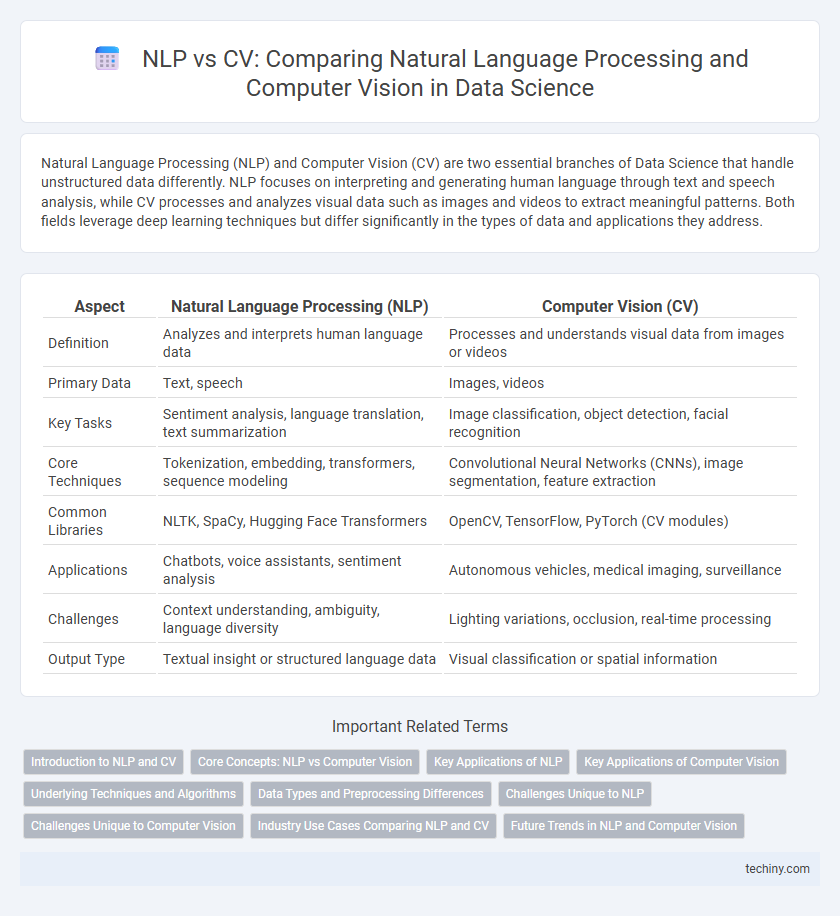Natural Language Processing (NLP) and Computer Vision (CV) are two essential branches of Data Science that handle unstructured data differently. NLP focuses on interpreting and generating human language through text and speech analysis, while CV processes and analyzes visual data such as images and videos to extract meaningful patterns. Both fields leverage deep learning techniques but differ significantly in the types of data and applications they address.
Table of Comparison
| Aspect | Natural Language Processing (NLP) | Computer Vision (CV) |
|---|---|---|
| Definition | Analyzes and interprets human language data | Processes and understands visual data from images or videos |
| Primary Data | Text, speech | Images, videos |
| Key Tasks | Sentiment analysis, language translation, text summarization | Image classification, object detection, facial recognition |
| Core Techniques | Tokenization, embedding, transformers, sequence modeling | Convolutional Neural Networks (CNNs), image segmentation, feature extraction |
| Common Libraries | NLTK, SpaCy, Hugging Face Transformers | OpenCV, TensorFlow, PyTorch (CV modules) |
| Applications | Chatbots, voice assistants, sentiment analysis | Autonomous vehicles, medical imaging, surveillance |
| Challenges | Context understanding, ambiguity, language diversity | Lighting variations, occlusion, real-time processing |
| Output Type | Textual insight or structured language data | Visual classification or spatial information |
Introduction to NLP and CV
Natural Language Processing (NLP) specializes in enabling machines to understand, interpret, and generate human language, utilizing techniques like tokenization, sentiment analysis, and language modeling to extract meaningful insights from textual data. Computer Vision (CV) focuses on teaching computers to interpret and process visual information through methods such as image recognition, object detection, and image segmentation, allowing automated understanding of visual content. Both NLP and CV leverage machine learning and deep learning models to transform unstructured data into actionable knowledge across diverse applications.
Core Concepts: NLP vs Computer Vision
Natural Language Processing (NLP) focuses on analyzing and interpreting human language through techniques like tokenization, sentiment analysis, and named entity recognition. Computer Vision (CV) centers on enabling machines to understand visual data by employing image processing, object detection, and convolutional neural networks. Both fields leverage deep learning but differ fundamentally in input types--text for NLP and images or videos for CV--resulting in unique algorithms and architectures tailored to their specific data modalities.
Key Applications of NLP
Natural Language Processing (NLP) enables machines to interpret, analyze, and generate human language, powering applications like sentiment analysis, language translation, and chatbots. Key NLP advancements include speech recognition, text summarization, and keyword extraction, which enhance customer service and automate content moderation. Unlike Computer Vision, which focuses on image and video analysis, NLP excels in extracting meaning from unstructured textual data for enhanced decision-making.
Key Applications of Computer Vision
Computer Vision (CV) enables machines to interpret and analyze visual data, powering key applications such as facial recognition, autonomous vehicle navigation, and medical image diagnostics. These applications leverage deep learning algorithms and convolutional neural networks (CNNs) to detect patterns and anomalies in images and videos. CV's ability to automate visual tasks enhances industries ranging from healthcare and security to retail and manufacturing.
Underlying Techniques and Algorithms
Natural Language Processing (NLP) primarily relies on techniques such as tokenization, word embeddings (e.g., Word2Vec, GloVe), and transformer architectures like BERT and GPT for understanding and generating human language. In contrast, Computer Vision (CV) utilizes convolutional neural networks (CNNs), image segmentation algorithms, and object detection methods like YOLO and Faster R-CNN to analyze and interpret visual data. Both fields leverage deep learning frameworks but differ significantly in data modalities and specialized algorithms tailored to text sequences versus image pixels.
Data Types and Preprocessing Differences
Natural Language Processing (NLP) primarily deals with unstructured text data such as sentences, paragraphs, and documents, requiring preprocessing steps like tokenization, stemming, and stop-word removal to convert raw text into meaningful features. Computer Vision (CV) works with visual data such as images and videos, where preprocessing often involves resizing, normalization, augmentation, and converting pixel values into tensors suitable for convolutional neural networks. While NLP focuses on linguistic structure and semantic meaning extraction from sequential data, CV emphasizes spatial patterns and visual feature extraction from multidimensional pixel arrays.
Challenges Unique to NLP
Natural Language Processing (NLP) faces unique challenges such as understanding context, ambiguity, and the complexity of human language structure, including syntax and semantics. Unlike Computer Vision (CV), which processes visual data with spatial and pixel-based patterns, NLP must decode diverse linguistic nuances, idiomatic expressions, and evolving vocabularies. Handling sarcasm, polysemy, and cultural references further complicates NLP model training and accuracy compared to CV tasks.
Challenges Unique to Computer Vision
Computer Vision faces unique challenges such as varying lighting conditions, occlusions, and complex backgrounds that can obscure object recognition and scene understanding. Unlike NLP, which primarily deals with linear text data, CV must process high-dimensional image and video data requiring sophisticated algorithms to interpret spatial and temporal information accurately. The demand for large annotated datasets and computationally intensive models further complicates the development and deployment of effective computer vision solutions.
Industry Use Cases Comparing NLP and CV
Natural Language Processing (NLP) excels in industries such as customer service, finance, and healthcare by enabling sentiment analysis, chatbots, and automated transcription. Computer Vision (CV) finds critical applications in manufacturing for quality inspection, autonomous vehicles for object detection, and retail for inventory management through image recognition. Both technologies drive digital transformation across sectors but address distinct data types--text for NLP and images or videos for CV--shaping their industry-specific use cases.
Future Trends in NLP and Computer Vision
Future trends in Natural Language Processing emphasize advancements in transformer architectures, enabling more accurate contextual understanding and real-time language translation. Computer Vision is progressing towards edge AI implementations, improving image recognition and object detection in autonomous systems with low latency. Both fields are increasingly integrating multimodal learning to enhance human-computer interaction across diverse applications.
NLP vs CV (Natural Language Processing vs Computer Vision) Infographic

 techiny.com
techiny.com